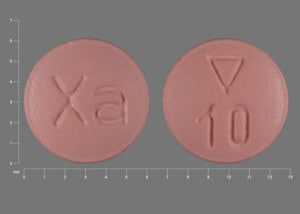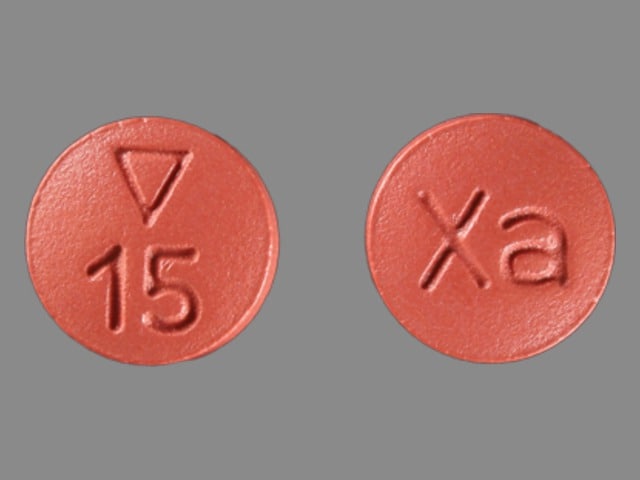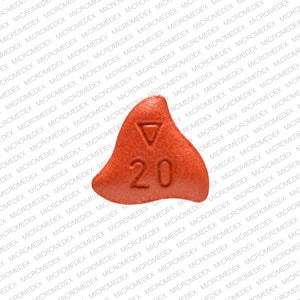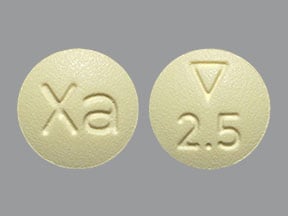What is Xarelto?
Xarelto is a prescription medicine used to:
- reduce the risk of stroke and blood clots in people who have a medical condition called atrial fibrillation that is not caused by a heart valve problem. With atrial fibrillation, part of the heart does not beat the way it should. This can lead to the formation of blood clots, which can travel to the brain, causing a stroke, or to other parts of the body.
- treat blood clots in the veins of your legs (deep vein thrombosis or DVT) or lungs (pulmonary embolism or PE).
- reduce the risk of blood clots happening again in people who continue to be at risk for DVT or PE after receiving treatment for blood clots for at least 6 months.
- help prevent a blood clot in the legs and lungs of people who have just had hip or knee replacement surgery.
- help prevent blood clots in certain people hospitalized for an acute illness and after discharge who are at risk of getting blood clots because of the loss of or decreased ability to move around (mobility) and other risks for getting blood clots and who do not have a high risk of bleeding.
Xarelto is used with low dose aspirin to:
- reduce the risk of serious heart problems, heart attack and stroke in people with coronary artery disease (a condition where the blood supply to the heart is reduced or blocked) or peripheral artery disease (a condition where the blood flow to the legs is reduced).
It is not known if Xarelto is safe and effective in children.
What is the most important information I should know about Xarelto?
Xarelto may cause serious side effects, including:
-
Increased risk of blood clots if you stop taking Xarelto
People with atrial fibrillation (a type of irregular heart beat) that is not caused by a heart valve problem (non-valvular) are at an increased risk of forming a blood clot in the heart, which can travel to the brain, causing a stroke, or to other parts of the body. Xarelto lowers your chance of having a stroke by helping to prevent clots from forming. If you stop taking Xarelto, you may have increased risk of forming a clot in your blood.
Do not stop taking Xarelto without talking to the doctor who prescribes it for you. Stopping Xarelto increases your risk of having a stroke. If you have to stop taking Xarelto, your doctor may prescribe another blood thinner medicine to prevent a blood clot from forming.
-
Increased risk of bleeding
Xarelto can cause bleeding which can be serious and may lead to death. This is because Xarelto is a blood thinner medicine (anticoagulant) that lowers blood clotting. During treatment with Xarelto you are likely to bruise more easily, and it may take longer for bleeding to stop. You may have a higher risk of bleeding if you take Xarelto and have certain other medical problems.
You may have a higher risk of bleeding if you take Xarelto and take other medicines that increase your risk of bleeding, including:
- aspirin or aspirin containing products
- long-term (chronic) use of non-steroidal anti-inflammatory drugs (NSAIDs)
- warfarin sodium (Coumadin, Jantoven)
- any medicine that contains heparin
- clopidogrel (Plavix)
- selective serotonin reuptake inhibitors (SSRIs) or serotonin norepinephrine reuptake inhibitors (SNRIs)
- other medicines to prevent or treat blood clots
Tell your doctor if you take any of these medicines. Ask your doctor or pharmacist if you are not sure if your medicine is one listed above.
Call your doctor or get medical help right away if you develop any of these signs or symptoms of bleeding:
- unexpected bleeding or bleeding that lasts a long time, such as:
- nose bleeds that happen often
- unusual bleeding from the gums
- menstrual bleeding that is heavier than normal or vaginal bleeding
- bleeding that is severe or you cannot control
- red, pink or brown urine
- bright red or black stools (looks like tar)
- cough up blood or blood clots
- vomit blood or your vomit looks like "coffee grounds"
- headaches, feeling dizzy or weak
- pain, swelling, or new drainage at wound sites
-
Spinal or epidural blood clots (hematoma)
People who take a blood thinner medicine (anticoagulant) like Xarelto, and have medicine injected into their spinal and epidural area, or have a spinal puncture have a risk of forming a blood clot that can cause long-term or permanent loss of the ability to move (paralysis). Your risk of developing a spinal or epidural blood clot is higher if:
- a thin tube called an epidural catheter is placed in your back to give you certain medicine
- you take NSAIDs or a medicine to prevent blood from clotting
- you have a history of difficult or repeated epidural or spinal punctures
- you have a history of problems with your spine or have had surgery on your spine
If you take Xarelto and receive spinal anesthesia or have a spinal puncture, your doctor should watch you closely for symptoms of spinal or epidural blood clots. Tell your doctor right away if you have back pain, tingling, numbness, muscle weakness (especially in your legs and feet), loss of control of the bowels or bladder (incontinence).
Xarelto is not for use in people with artificial heart valves.
Xarelto is not for use in people with antiphospholipid syndrome (APS), especially with positive triple antibody testing, who have a history of blood clots.
Who should not take Xarelto?
Do not take Xarelto if you:
- currently have certain types of abnormal bleeding. Talk to your doctor before taking Xarelto if you currently have unusual bleeding.
- are allergic to rivaroxaban or any of the ingredients in Xarelto. See the end of this Medication Guide for a complete list of ingredients in Xarelto.
What should I tell my healthcare provider before taking Xarelto?
Before taking Xarelto, tell your doctor about all of your medical conditions, including if you:
- have or ever had bleeding problems
- have liver or kidney problems
- have antiphospholipid syndrome (APS)
- are pregnant or plan to become pregnant. It is not known if Xarelto will harm your unborn baby.
- tell your doctor right away if you become pregnant during treatment with Xarelto. Taking Xarelto while you are pregnant may increase the risk of bleeding in you or in your unborn baby.
- if you take Xarelto during pregnancy tell your doctor right away if you have any signs or symptoms of bleeding or blood loss. See "What is the most important information I should know about Xarelto?" above for signs and symptoms of bleeding.
- are breastfeeding or plan to breastfeed. Xarelto can pass into your breast milk. Talk to your doctor about the best way to feed your baby during treatment with Xarelto.
Tell all of your doctors and dentists that you are taking Xarelto. They should talk to the doctor who prescribed Xarelto for you before you have any surgery, medical or dental procedure.
Tell your doctor about all the medicines you take, including prescription and over-the-counter medicines, vitamins, and herbal supplements.
Some of your other medicines may affect the way Xarelto works, causing side effects. Certain medicines may increase your risk of bleeding. See "What is the most important information I should know about Xarelto?" above.
Especially tell your doctor if you take:
- ketoconazole
- erythromycin
- phenytoin
- St. John's wort
- ritonavir
- carbamazepine
- rifampin
How should I take Xarelto?
- Take Xarelto exactly as prescribed by your doctor.
- Do not change your dose or stop taking Xarelto unless your doctor tells you to. Your doctor may change your dose if needed.
- Your doctor will decide how long you should take Xarelto.
- Xarelto may need to be stopped for one or more days before any surgery or medical or dental procedure. Your doctor will tell you when to stop taking Xarelto and when to start taking Xarelto again after your surgery or procedure.
- If you need to stop taking Xarelto for any reason, talk to the doctor who prescribed Xarelto to you to find out when you should stop taking it. Do not stop taking Xarelto without first talking to the doctor who prescribes it to you.
- If you have difficulty swallowing Xarelto tablets whole, talk to your doctor about other ways to take Xarelto.
- Do not run out of Xarelto. Refill your prescription of Xarelto before you run out. When leaving the hospital following a hip or knee replacement, be sure that you will have Xarelto available to avoid missing any doses.
- If you take too much Xarelto, go to the nearest hospital emergency room or call your doctor right away.
If you take Xarelto for:
-
Atrial fibrillation that is not caused by a heart valve problem:
- Take Xarelto 1 time a day with your evening meal.
- If you miss a dose of Xarelto, take it as soon as you remember on the same day. Take your next dose at your regularly scheduled time.
- Blood clots in the veins of your legs or lungs:
- Take Xarelto 1 or 2 times a day as prescribed by your doctor.
- For the 10 mg dose, take Xarelto with or without food.
- For the 15 mg and 20 mg doses, take Xarelto with food at the same time each day.
- If you miss a dose:
- If you take the 15 mg dose of Xarelto 2 times a day (a total of 30 mg of Xarelto in 1 day) : Take Xarelto as soon as you remember on the same day. You may take 2 doses at the same time to make up for the missed dose. Take your next dose at your regularly scheduled time.
- If you take Xarelto 1 time a day: Take Xarelto as soon as you remember on the same day. Take your next dose at your regularly scheduled time.
- Hip or knee replacement surgery:
- Take Xarelto 1 time a day with or without food.
- If you miss a dose of Xarelto, take it as soon as you remember on the same day. Take your next dose at your regularly scheduled time.
- Blood clots in people hospitalized for an acute illness:
- Take Xarelto 1 time a day, with or without food, while you are in the hospital and after you are discharged as prescribed by your doctor.
- If you miss a dose of Xarelto, take it as soon as you remember on the same day. Take your next dose at your regularly scheduled time.
- Reducing the risk of serious heart problems, heart attack and stroke in coronary artery disease or peripheral artery disease:
- Take Xarelto 2 times a day with or without food.
- If you miss a dose of Xarelto, take your next dose at your regularly scheduled time.
What are the possible side effects of Xarelto?
Xarelto may cause serious side effects:
- See "What is the most important information I should know about Xarelto?" above
The most common side effect of Xarelto was bleeding.
Call your doctor for medical advice about side effects. You may report side effects to FDA at 1 800-FDA-1088.
Xarelto Images
Drug Interactions
A total of 382 medications are known to interact with Xarelto. Use the Interactions Checker Tool.
Common Interactions Checks
General information about the safe and effective use of Xarelto
Medicines are sometimes prescribed for purposes other than those listed in a Medication Guide. Do not use Xarelto for a condition for which it was not prescribed. Do not give Xarelto to other people, even if they have the same symptoms that you have. It may harm them. You can ask your pharmacist or doctor for information about Xarelto that is written for health professionals.
How should I store Xarelto?
- Store Xarelto at room temperature between 68°F to 77°F (20°C to 25°C).
Keep Xarelto and all medicines out of the reach of children.
What are the ingredients in Xarelto?
Active ingredient: rivaroxaban
Inactive ingredients: croscarmellose sodium, hypromellose, lactose monohydrate, magnesium stearate, microcrystalline cellulose, and sodium lauryl sulfate.
The proprietary film coating mixture for Xarelto 2.5 mg tablets is Opadry Light Yellow and contains: ferric oxide yellow, hypromellose, polyethylene glycol 3350, and titanium dioxide.
The proprietary film coating mixture for Xarelto 10 mg tablets is Opadry Pink and contains: ferric oxide red, hypromellose, polyethylene glycol 3350, and titanium dioxide.
The proprietary film coating mixture for Xarelto 15 mg tablets is Opadry Red and contains: ferric oxide red, hypromellose, polyethylene glycol 3350, and titanium dioxide.
The proprietary film coating mixture for Xarelto 20 mg tablets is Opadry II Dark Red and contains: ferric oxide red, polyethylene glycol 3350, polyvinyl alcohol (partially hydrolyzed), talc, and titanium dioxide.






